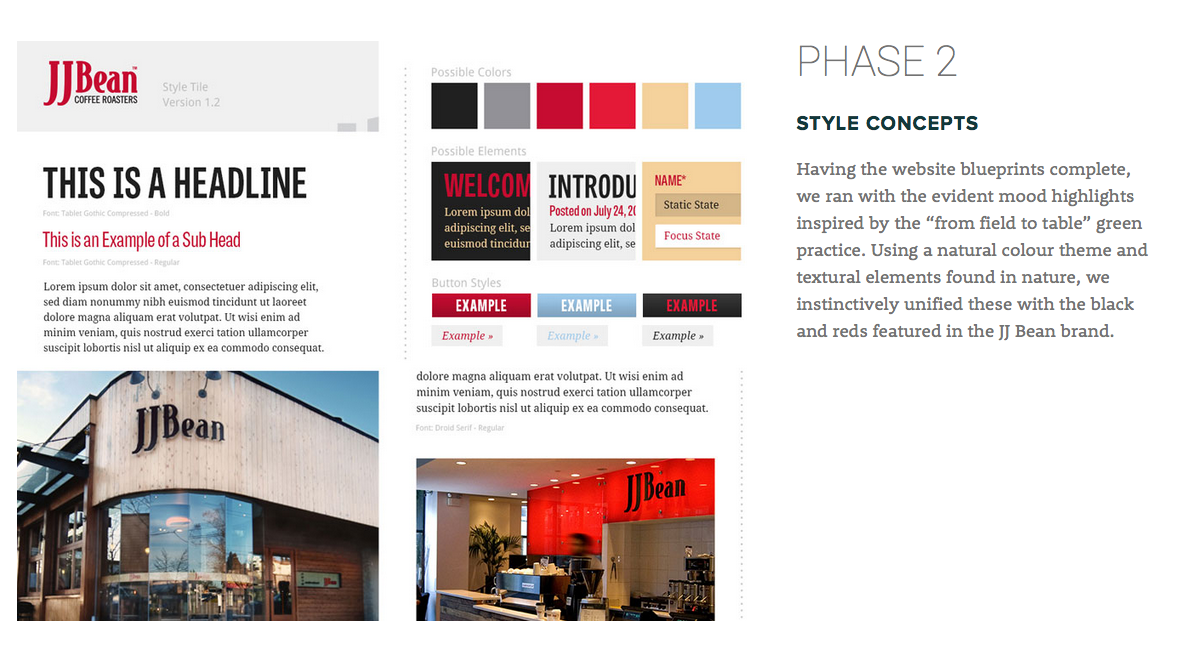Secrets to Powerful Web Design Case Studies
Key Takeaways
- Case studies are a powerful tool to demonstrate your web design process and problem-solving abilities to potential clients, showing not only the final product but the entire journey from start to finish.
- Choose your case study subjects carefully, ideally a client that most of your future clients can identify with; make sure to include real, quantifiable results to give future clients concrete evidence of your abilities.
- Present your case studies in a digestible way, using techniques such as breaking up paragraphs, using headings and subheadings, lists, and incorporating images to make the content engaging and easy to consume.
- Position your case studies strategically on your portfolio website to maximize their impact; consider dedicated pages, sidebars, and homepage features to draw attention to them.
- Regularly update your case studies to showcase your most recent work and demonstrate your continuous improvement and active engagement in your field.
If you don’t know about the power of case studies yet, pay close attention; they are about to become your best friend.
For the most part, case studies are a mainstay of nearly every industry. Companies of all types use case studies to show the world how they helped solve a problem or issue for one specific client.
Remember back in school when the teacher wanted you to show your work? A case study works on the same principle. Some clients want to get a “peek behind the curtain,” and see the processes involved in your work.
They want to see not only how the finished product looks, but also the entire process from start to finish.
- How did you take a client’s problem and develop a solution?
- How long did it take, and what was involved along the way?
- What was your thought process, and what did you do in order to solve a client’s problem or achieve their goals?
These are some of the questions that are typically answered in case studies, and they provide a lot of insight for clients.
Case studies can also take many forms, and may not even be called case studies at all. For example, my website thedeependdesign.com refers to them as “Success Stories.” You can tailor your own phrase, creating something that’s engaging and works for you.
Regardless of titles, a case study tells the story of how you helped one specific client. This is important, because if a future client can identify with a past client – their problem, their goal, whatever it may be – they can see how you might help them in a similar way.
Strangely, very few freelancers seem to use case studies, while larger companies – especially in creative industries – are using them quite extensively. This is a real missed opportunity, but if you stop and think about it, this is great news for you.
If you are one of the only ones in your market to utilize case studies for your business, you can really stand out from the crowd. This will make you and your business that much more attractive to potential clients if you are one of the few people on board with using this technique.
By their nature, case studies also show that you understand and have experience in solving problems. They help show clients that you can take a unique situation, problem, or goal and create a process to help your client get exactly what they want.
Part 1: How to Craft a Compelling Web Design Case Study
Choose your subjects carefully.
The first step toward a great case study is choosing the right subject. If you have the luxury of a lot of past clients to choose from, it’s probably wise to choose an “everyman” client that the majority of your future clients can identify with. Someone that people can understand who has a problem or goal that a lot of other businesses share.

Choosing a client from an obscure or complicated industry that will require lots of explanation will make it more difficult for potential clients to relate. If people can’t relate to your case studies, they’re unlikely to be able to see you solving their problems.
Consumer-facing clients such as restaurants, retail shops or hotels often have easily recognizable goals and make for excellent case studies.
Also, keep in mind your target client base when picking your subject. Make sure you choose a candidate that will appeal to the types of clients you want to attract.
For example, if you happen to be successful in producing web design for the construction industry, try to stick to that area for your case study, or you run the risk of not relating to your bread-and-butter clients.
Being able to identify with the client in the case study is critical because we want the reader to be able to easily project themselves into the client’s shoes. You want them to read it, sit back and think ‘He did a great job for that guy, and I have similar issues. I bet he could help me too.’
However, if you’re newish business you may not have a long client list and so you won’t be able to be as picky. But that’s okay – everyone starts somewhere, and as you gain more clients, you can write more and more case studies and get pickier as time progresses.
If you happen to be brand new, with no past clients to write a case study on, you can write a case study in real time. This can actually be a good thing, as you’ll be able to write the case study on a client you’re currently helping, and all the details will be fresh in your mind.
Get Writing!
Now that you have your client picked out, it’s time to start crafting. Remember, you want to tell a story from start to finish. Beginning with when your client first came to you:
- What was the problem or goal that drove them to you in the first place
- What did they need you to solve?
- Did they need a logo designed, a press release written, or a brand new website designed?
Talk about any and all prerequisites that came with the project. For instance, a client may come to you wanting a website that can be easily updatable by their own staff, they want to bring in the colors and theme of their existing logo, or be able to collect email addresses.
These prerequisites all amount to limitations on your creativity. This is an excellent thing to show, as it tells future clients that you can operate within the boundaries of what your clients ask for.
You should also include other unspoken considerations that you took into account during the process. This could include industry-standard features that you happened to uncover in your research.
A good example of this would be if a new restaurant wanted you to build a website for them, and you found out during your research phase that most restaurants are using a service called “OpenTable” to take online reservations.
Talk about:
- All elements that were required.
- All elements the client specifically requested.
- Things that you found out on your own.
Include how you took all these things into account as you came up with a solution for the final product. Explain your thought process behind your decisions and show how your decisions influenced and benefited the project and the client.
Quantify whenever you can.
Always include real, accurate numbers whenever you can. It’s one thing to say “My web design contributed to the construction firm’s success.’, but it’s much better to say ‘The website I designed for XYZ client gets 10,000 unique visitors a month, with 10% of them converted into sales leads.”

These are quantifiable statistics that future clients can read and easily understand. Visitors don’t have to wonder what it actually means, or think about your statements in an abstract way – it’s real world data that is easily interpreted.
They want to know that if they hire you for a project, that you’ll get them results. And real results are measured in numbers, not in warm fuzzy feelings.
Part 2: How to Present Your Case Studies
One you’ve determined the content for an effective case study, it’s time to focus on the presentation. People aren’t looking to read a 400-page novel about your past clients, so it’s important to present case studies in an easily digestible way and will make people want to read them.
First and foremost, you want to make sure your case studies are formatted correctly for the web, and specifically, for your website. Think about some of the blogs and other websites that present a large amount of information – most of them do an excellent job of being able to present it in such a way that’s easy to navigate and read. They do this by breaking up the content into bite-sized chunks.
Break it Up.
Breaking up paragraphs is an easy way to start. It looks much nicer to the reader’s eye, and it’s easier to read than just one giant wall of text. Too much text looks intimidating, and quite frankly like a chore to read.
Breaking it up into paragraphs makes it look much more accessible, and potential clients can jump around to see which paragraphs interest them the most if they don’t feel like reading the entire page.
Use headers.
Also, use headings and subheadings where appropriate. These allow you to break up your content even further, and also enhance a reader’s ability to scan and find exactly what interests them. For the most part, people aren’t usually going to read the entire case study. People’s reading habits online are actually pretty lazy – so most people are just going to scan the content and read what appeals to them specifically.
Use lists.
Do you have information is your case study that could be formatted as a list? Lists and bullet points are an effective way to make content easy to consume.
Bullet points are particularly well-suited for listing the specific requirements of the project, features you implemented, or statistics about how the project benefitted your client.
Use images.
Always use images wherever you can – show the different stages of the projects alongside your content if at all possible. Anytime you can show rather than tell, it’s a good thing.

If you can show your projects in as many stages as possible, do so. For instance, if you worked on a logo, you might want to show screenshots of your beginning sketches.
Then move on to how you began looking for various colors, show images of the color schemes you may have plugged into your design. Again, case studies are all about telling the story of a project, so do this with images whenever possible.
Speaking of images, ask your client if you can use a picture of them. After all, it’s promoting them and their business too.
The simple addition of a client photograph immediately makes them more “real” to other potential clients. If people can see who you’re talking about, it makes the entire case study more relatable and personable.
Part 3: Position Your Case Studies for Maximum Impact
You know how supermarkets place gum, candy, soda and magazines right at the register? It’s no accident. They know that once you are there, these small, innocuous, low-priced items will seem like a perfectly reasonable add-on to what you are already purchasing. It’s just one last “push” to make an extra sale.
Well, case studies can work in a similar way to your portfolio website.
Since you have gone to all the time and trouble writing a compelling case study and presenting it in an effective way, you’ll want to put it in the best position possible on your portfolio site. As with everything else on your website, location makes a big difference. So where’s the best location for your case studies?
Location 1: A Dedicated Page
The first and most obvious location is on a dedicated “case studies” page, to be included in the main navigation. Clicking the navigation should bring visitors to the main page that will contain all of your case studies.
Even if you start with just one, it can still be a powerful tool. You can then add to them at your own pace as you start building up more and more clients.
On the page itself, you can lay them out however you like, though the layout will often depend on how many case studies you have to work with.
If you have several, you might want to have one featured case study on top that would be called out as such. The featured case study can have a lot of the information on the main page. This is where bullet points or number lists come in handy. Adding an image or two, and an overview of the case study with points that are covered can help draw people in. A link to “read more” allows people to view the entire case study if they want.
Other case studies can be arranged as thumbnails underneath the featured one, where a person can quickly scan the visual images and click on one that appeals to them. A quick link below each thumbnail, perhaps with the client and project name allows a person to click deeper and learn more.
If you are just starting out and have only one case study, you may want to use the same format but put all the information on the main page instead of a call-to-action to learn more. You can write something like “More coming soon” at the bottom of the page, and add more as you accumulate them.
You can make your case studies even more effective by strategically sprinkling them around other areas of the site as well, with links back to the main case studies page. Adding them to other pages can act almost like an “impulse buy” item at a supermarket as I mentioned before; Just that something extra to entice a visitor who might be on the fence about contacting you. So where else would it make sense for you to add studies to your site?
Location 2: On the Sidebar
One effective area is to add studies – or thumbnails of the studies – to the sidebar of your “My Work” page. That way, clients who are looking through your previous work have the option to dig deeper and read a bit more in-depth if they choose to.
And since it’s right there and they’re already looking over your work, most serious clients will click over and, at least, scan the main case studies page.
Location 3: On the Homepage
The homepage is generally the most visited page on a website and yours’ is likely no different. For this reason, it is another great place to put a featured case study. Within the homepage, there are many locations you could add a featured case study.
If you use a large slider, why not design a slide that calls out your featured case study? You can include a great image of the finished project, a simple headline, and a link to click and read the whole story.
Or perhaps you could put several of them a little lower on the page, either side-by-side thumbnails, or you could even design a mini-slider that rotates 3 or 4 case studies, with links of course.
The possibilities are virtually endless. Just be creative and position your case studies in areas of your site where it makes sense, especially in areas that it can enhance the page’s content. Adding them as a call-to-action or “impulse buy” helps add credibility to your site and gets people to stay on your site longer.
Frequently Asked Questions about Powerful Web Design Case Studies
What makes a web design case study powerful?
A powerful web design case study is one that effectively demonstrates the designer’s skills, creativity, and problem-solving abilities. It should clearly outline the project’s objectives, the challenges faced, the solutions implemented, and the results achieved. High-quality visuals, such as screenshots and mockups, are also crucial to help readers visualize the design process and the final product. A compelling narrative that tells the story of the project from start to finish can also make a case study more engaging and memorable.
How can I write a compelling narrative for my web design case study?
Writing a compelling narrative for your web design case study involves telling a story that engages your audience. Start by setting the scene with a brief introduction to the project, including the client, the project’s objectives, and the challenges faced. Then, describe the design process in detail, explaining the decisions you made and why. Finally, present the results achieved and reflect on what you learned from the project. Use clear, concise language and avoid jargon to make your case study accessible to a wide audience.
What kind of visuals should I include in my web design case study?
Visuals are a crucial part of any web design case study. They help readers visualize the design process and the final product. Include screenshots of the website at different stages of the design process, mockups, wireframes, and other design documents. You can also include images of the team working on the project or other behind-the-scenes photos. Make sure all visuals are high-quality and clearly labeled.
How can I showcase my problem-solving skills in my web design case study?
Showcasing your problem-solving skills in your web design case study involves clearly outlining the challenges you faced during the project and explaining how you overcame them. Describe the solutions you implemented, why you chose them, and how they contributed to the project’s success. Use specific examples and provide evidence to support your claims, such as before-and-after screenshots or testimonials from the client.
How can I make my web design case study more engaging?
Making your web design case study more engaging involves using a variety of techniques to keep your audience’s attention. Use a compelling narrative to tell the story of the project, include high-quality visuals to illustrate your points, and use clear, concise language to make your case study easy to read. You can also include interactive elements, such as videos or interactive prototypes, to make your case study more dynamic and engaging.
How can I demonstrate the results achieved in my web design case study?
Demonstrating the results achieved in your web design case study involves providing concrete evidence of the project’s success. This could include metrics such as increased website traffic, improved conversion rates, or positive feedback from the client. Include before-and-after comparisons to show the impact of your design changes, and use testimonials or quotes from the client to provide third-party validation of your work.
How can I reflect on what I learned from the project in my web design case study?
Reflecting on what you learned from the project in your web design case study involves taking a step back and considering the bigger picture. Discuss what went well, what didn’t, and what you would do differently next time. This shows your ability to learn from your experiences and continuously improve your skills and processes. It also provides valuable insights for other designers who may be facing similar challenges.
How can I make my web design case study accessible to a wide audience?
Making your web design case study accessible to a wide audience involves using clear, concise language and avoiding jargon. Explain any technical terms or concepts that your audience may not be familiar with. Also, consider the design of your case study itself. Use a clean, easy-to-read layout, high-contrast colors, and large, legible fonts. Include alt text for images and captions for videos to make your case study accessible to people with visual impairments.
How can I use my web design case study to attract potential clients?
Your web design case study can be a powerful tool for attracting potential clients. It showcases your skills, creativity, and problem-solving abilities, and provides concrete evidence of your ability to deliver successful projects. Make sure your case study is easy to find on your website, and consider sharing it on social media or in your email newsletter. Include a call to action at the end of your case study, inviting potential clients to get in touch with you for more information.
How often should I update my web design case studies?
Updating your web design case studies regularly is important to keep them relevant and showcase your most recent work. Consider updating your case studies every time you complete a significant project, or at least once a year. This shows potential clients that you are active and continuously improving your skills and processes. It also gives you the opportunity to reflect on your work and learn from your experiences.
Wes McDowell is the Principal and Creative Director forThe Deep End Design in Chicago. In addition to client work, he has authored several books for freelance designers and co-hosts a popular graphic design podcast called The Deeply Graphic DesignCast.

Published in
·Animation·CSS·Design·Design & UX·HTML·HTML & CSS·Illustration·Prototypes & Mockups·UI Design·February 8, 2017
Published in
·Debugging·Development Environment·Meta·Patterns & Practices·PHP·Programming·July 1, 2014
Published in
·JavaScript·Patterns & Practices·Performance & Scaling·PHP·Programming·Ruby·Web·October 10, 2014



